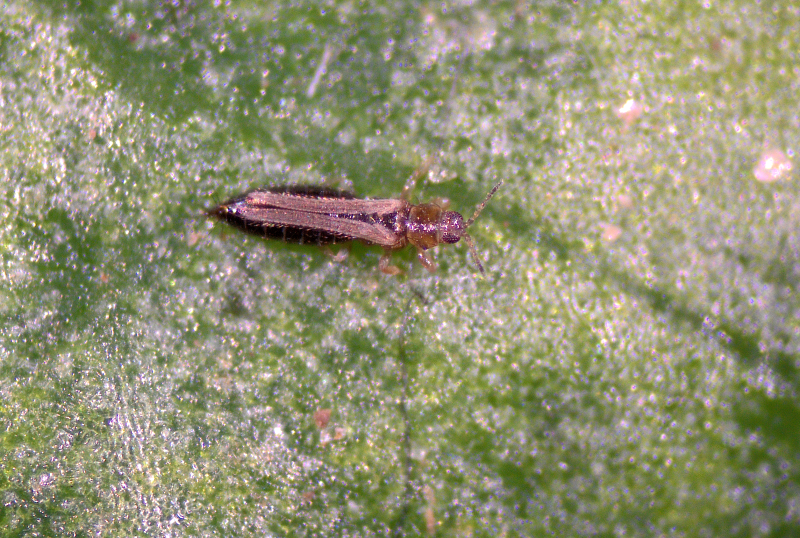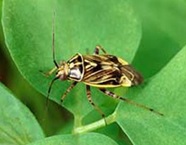As the cotton and peanut season begins across the Panhandle, I want to bring a few things to your attention regarding early insect pests this season. Our biggest questions regarding early-season cotton are: 1) What does the thrips situation look like? and 2) When/what are we going to need to spray? Looking at the Thrips Infestation Predictor for Cotton for a trial we planted earlier this week at the NFREC Quincy location in Gadsden County, our greatest risk for thrips infestations occurs in cotton and peanut planted mid-late April to the first week of May, with a lower risk toward the end of May. We will briefly discuss the new Thryvon cotton varieties containing new plant bug traits, thrips related planting decisions in cotton and peanut, and plant bug management in cotton.

Planting date risk for thrips for our trial at the NFREC Quincy. The planting date of 4/22/24 is a black bar in the figure. Image created from NC State Thrips Infestation Predictor: https://products.climate.ncsu.edu/ag/cottontip/
–
What is ThryvOn Cotton?
What is ThryvOn cotton? It is a new cotton technology expressing the Bacillus thuringiensis (Bt) Cry51Aa2 developed by Bayer CropScience. While it was commercially available for the 2023 growing season, we did not see much of it across the Panhandle. This technology has activity against two significant pests, thrips (tobacco thrips) and tarnished plant bugs. It has been shown to reduce populations of both species during critical periods of the season when they can cause economic damage across the Southeast (including a Trial on station at the NFREC last season). In our trial, untreated controls of ThryvOn (DP 2131 BG3TXF) kept thrips populations and injury significantly lower than its non-TryvOn counterpart (DP 1646), even with insecticide treatments. This reduction in population and injury seems to be tied mainly adult non-preference. This year, we will compare it to a non-ThryvOn 3 gene variety, and we will update you at the end of the season.
In addition to thrips, ThryvOn technology also has activity on tarnished plant bugs. Like thrips, adult non-preference plays a role in the reduced plant bug populations and damage found in ThryvOn cotton. In addition to feeding less, adult plant bugs deposit fewer eggs in ThryvOn cotton. Although populations and injury are less in ThryvOn cotton than in non-ThryvOn cotton, threshold populations and injury can be observed and may require treatment.
–
Thrips Management in Cotton and Peanut:
The best option for thrips management comes at planting in the form of an insecticide seed treatment (ISTs) of imidacloprid (Gaucho) or an in-furrow insecticide application of either imidacloprid (Admire Pro 9.2oz/a) or aldicarb (AgLogic 5lb/a). The performance of ISTs will vary by year and location, driven by weather and the extent of thrips pressure. If you have high thrips pressure, or less than ideal growing conditions during seedling stages, IST fields may require a foliar application to supplement the IST. Under low thrips pressure and good growing conditions, ISTs can do an excellent job without needing a supplemental foliar application. More so in ThryVon varieties.

Frankliniella fusca (tobacco thrip) adult on the underside of a cotyledon. Photo Credit: I.L.Esquivel, UF/IFAS
–
When a foliar application is necessary, getting out and sampling your fields is essential. Cotton is most susceptible to thrips injury at the cotyledon stage, 1st true leaf up to the 5th true leaf. A foliar application is not recommended after the 5th true leaf with vigorous growth. The recommended threshold for thrips is 25% or more of sampled plants showing moderate to significant thrips injury, and an average of two or more immature thrips are present. Under these conditions, treatment may be necessary. As far as foliar options, Acephate (3 oz/A) is an effective and rather economical option. Pyrethroids are not recommended to control thrips and have the potential to flare secondary pests like aphids and spider mites.
For peanut, our only option to manage thrips comes at planting. If you have not planted yet, I highly recommend using Phorate (Thimet @ 5-7.5 lbs./A) in-furrow for thrips management. It is the only option that will BOTH kill thrips and reduce the chances of tomato-spotted wilt infection. Other in-furrow options like imidacloprid will kill thrips but WILL NOT reduce the incidence of tomato spotted wilt. If you are worried about thrips after the furrow is closed, we can make foliar insecticide applications to manage thrips, but these sprays WILL NOT reduce the risk of TSWV. Contact your county extension agent if you are considering a foliar application. For questions about thresholds and alternative treatments for thrips in cotton and peanut, contact myself or your county extension agent.
–
Plant Bug Management in Cotton
Plant bugs are already here! Last week, we found a good population of adults in a carinata planting at the North Florida Research and Education Center (NFREC), in Quincy.
In pre-bloom cotton, the current recommended threshold is eight adults per 100 sweeps or to maintain 80% square retention. Whatever threshold you use, both are critical for plant bug management in current varieties. However, the threshold population of eight bugs may not often result in >20% pinhead square loss. Adult plant bugs deposit eggs that will hatch into immatures over the following weeks. Proper scouting and insecticide timing can help to reduce the populations of immature plant bugs observed in cotton in early bloom.
As cotton begins to bloom, immature plant bugs become the focus of scouting efforts. Immature plant bugs prefer to feed on larger squares, often hidden inside bracts, making insecticide coverage difficult. The recommended threshold for immature plant bugs is three per five row-feet, sampled with a drop cloth (I recommend using a black drop cloth to spot the green immatures easily). Research in the Southeast suggests this threshold should be followed in ThryvOn cotton as it is in non-ThryvOn cotton. One advantage of ThryvOn cotton is that often, in low plant bug pressure areas, populations build slower than in non-ThryvOn cotton. This means that the window of opportunity to spray is longer. In other words, in rainy periods or areas where fields are spaced out across large areas, the importance of the timeliness of the insecticide application is not as great. While timeliness will still be important, plant bugs are not doing as much damage in the lag time between sprays.
If you have any questions about ThryvOn cotton or early season planting decisions and pest management, contact myself or your county extension agent. If you are planting ThryvOn this year, also reach out to me as we would like to sample your field to quantify insect populations.

